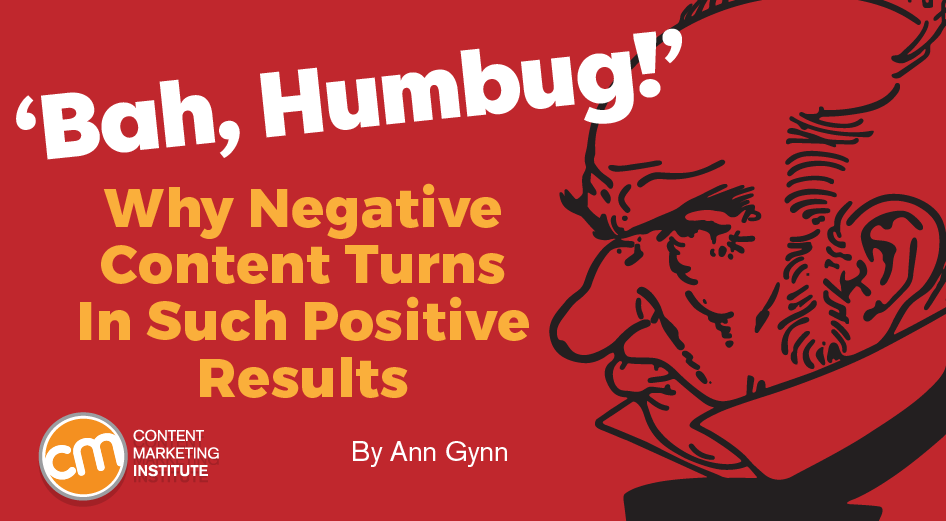MARKETING
‘Bah, Humbug!’ Why Negative Content Turns In Such Positive Results

People love to hate Steven Singer.
That “hate” is so pervasive that the jewelry retailer’s website is: IHateStevenSinger.com. The company is so committed to celebrating the “hate” that it doesn’t even own the domain StevenSinger.com.
What’s behind all that “hate” pervading Philadelphia radio and satellite airwaves? (The company says it’s the longest-running advertiser on The Howard Stern Show.) It’s the story of customer feedback (possibly apocryphal) that launched a marketing campaign that’s lasted for years.
It’s also a story about the power of contrarian thinking – a helpful reminder for content marketers.
@IHSS (I Hate Steven Singer) shows the power of contrarian thinking, a useful #ContentMarketing lesson, says @AnnGynn via @CMIContent. Click To Tweet
Contrarian strategy stands out in a gift-driven market
The website’s History page recounts the origin story: A Steven Singer customer returned 20 years after buying an engagement ring to buy another diamond ring for their anniversary. About nine months later, the couple returned to the jewelry store to show off their new baby. The wife exclaimed, “I love Steven Singer,” to which the husband responded, “Here we go again. We’re up all night with feedings and diaper changes. I HATE Steven Singer.”
(Here’s the audio explanation used in their commercials.)
Steven Singer Jewelers turned that funny comment into a brand point of view.
A blog post called Why Hate Steven Singer explains recounts why big retailer jewelers hate Steven Singer:
- Steven Singer Jewelers says it doesn’t discount because it offers the best price from the beginning and mocks other jewelers’ big discount sales
- The independent jeweler criticizes the lower-quality diamonds sold by the big stores, referring to them by their industry name, “frozen spit.”
- Steven Singer lets customers upgrade purchases from the company by giving them a trade-in value equivalent to the price they originally paid.
The contrarian messaging continues throughout the site. The site list the business address as “the other corner of Eighth and Walnut” in Philadelphia. Even the Oops message (shown below) continues the theme, declaring, “Steven hated this page … so he moved it. Try these instead.”
How to craft a contrarian content marketing approach
A contrarian or negative approach can transform your content marketing strategy.
The goal is to get your audience to say, “Wait, what?!”
Subverting the expectations of audiences dulled to similar messaging gives them pause – and entices them to decipher what you’re talking about.
You can apply elements of opposite or negative thinking to individual assets or make it the “voice” of your content, as Steven Singer does.
A contrarian, negative, or opposite-thinking strategy is bold –some people may not understand what you’re doing. Just make sure your brand’s leadership does. Otherwise, they’ll stop it almost as soon as you publish it.
Here are a few ways to put that strategy into action (once it’s approved).
A contrarian or negative #ContentStrategy is bold. Not everyone will get it. Just make sure your leadership does, says @AnnGynn via @CMIContent Click To Tweet
Write an unexpected lead
Start small by crafting introductions to articles using opposite messaging. This small step can help you test whether your audience is receptive to this approach.
Try this exercise internally to ensure your team understands what you want them to do: Give the writers an article you already published and ask them to rewrite the lead following the contrarian, negative, or opposite-thinking strategy.
Example:
Fast Company published an article with this intro:
After nearly three years of a global pandemic and months, if not years, of working from home, the main thing drawing workers back to their offices is the desire to simply focus on their work. But at the same time, offices in the U.S. have hit a 15-year low when it comes to how effective they are for enabling focused work.
This troubling mismatch is one of the top takeaways from the 2022 U.S. Workplace Survey from the Gensler Research Institute, the research arm of the global architecture and design firm Gensler.
Contrarian-strategy revision:
U.S. workers don’t know what they’re talking about.
That’s the revelation from the 2022 U.S. Workplace Survey from the Gensler Research Institute.
Its survey found the most popular reason for workers wanting to return to the office is to focus on their individual work. Yet, it also finds U.S. offices are at a 15-year low in how effective they are for enabling focused work.
The original version focuses on what people say they want. The negative-strategy version exposes the mismatch between what people say they want and the reality of office environments.
The tone is eye-catchingly negative, and the sentence makes a U.S.-based audience curious to discover why they may be wrong.
Dig deeper for thought leadership content
You’ll attract a bigger audience if your thought leadership isn’t the same old same old. But that doesn’t mean you should take an opposing view if you don’t believe it.
The next time you tackle a thought leadership asset, research what’s already written or said about the topic and how it’s typically expressed. Then, ask if your view on the topic differs from your content competitors’.
If so, brainstorm the possibilities and pick the one most relevant to your audience. If not, you can still create something different by looking for an underdeveloped or unaddressed point or angle on this topic.
When reacting to published research, most people write thought leadership pieces around the first statistic or two. To create something that bucks the mainstream (without taking an opposite view you don’t believe), go deeper into the results. Find different stats relevant to your interest audience and frame your content around that.
You’ll attract more attention if your approach to thought leadership avoids the same-old story, says @AnnGynn via @CMIContent. Click To Tweet
Example:
Let’s use the 2022 U.S. Workplace Survey again. The Fast Company article focused on the workplace effectiveness chart presented on the webpage for the report (as the screenshot below shows).
Unexpected alternative:
But you can dig deeper into the research to find a fresh angle.
With most people focused on the first or most obvious chart, look for something less expected buried deeper in the research.
The chart at the bottom of the report web page (as shown in the screenshot below) looks at the respondents’ “ideal mix” of experiences for a company workplace. The chart shows the percentages for eight categories: clubhouse, coffee shop, library, creative lab, boutique hotel, residential, conference center, and corporate.
A content marketer in a relevant industry could craft a thought leadership piece around the office experiences workers want.
Think beyond content creation
While the Steven-Singer strategy makes sense for content creation, it also can work for other components of your content marketing program.
Marketers often want to know the best time and day to send an email, post to social, etc. You do a Google search and find Tuesdays are the best day to send emails. That same report indicates that the best time to send email is between 9 a.m. and noon.
Of course, since so many others will see that same window listed as a best practice, email inboxes get flooded between 9 a.m. on noon on Tuesdays. Why not send your emails later in the day or on a different day of the week?
Test the alternate send time for a few weeks to see if that opposite-thinking strategy works for your audience. If not, you can always switch back.
Don’t forget about your content formats, either.
CMI’s most recent B2B research found that most marketers (89%) use articles and posts of less than 1,500 words for content marketing. Other commonly used formats include:
- Videos of any length (75%)
- Case studies (67%)
- Virtual events/webinars/online courses (62%)
- Infographics/charts/data visualization/3D models (61%)
- Long articles/posts (more than 1,500 words)
- E-books and white papers (59%)
- In-person events (49%)
On the other hand, only 17% of marketers use print magazines and books.
That’s an opposite-strategy opportunity. Could you develop a print magazine for your audience? Given how few marketers do, your content would stand out.
If print isn’t feasible, think about other lesser-used types, such as audio content (used by 33% of marketers), research reports (used by 30%), or livestreaming content (16%).
TIP: An opposite-thinking strategy for content formats doesn’t require you to abandon the original format. Look for ways to repurpose content planned for popular formats into less-used ones.
You can apply an opposite-thinking content strategy without rejecting common formats, says @AnnGynn via @CMIContent. Click To Tweet
Become the most ‘hated’ content marketing
Your content competitors will only continue to grow in the months, decades, and years to come. The need to stand out and attract attention and interest from your audience never goes away.
With that in mind, adopting a Steven-Singer strategy for your content makes sense. And who knows? It might just be the ticket to results that everybody likes.
HANDPICKED RELATED CONTENT
Cover image by Joseph Kalinowski/Content Marketing Institute
!function(f,b,e,v,n,t,s)
{if(f.fbq)return;n=f.fbq=function(){n.callMethod?
n.callMethod.apply(n,arguments):n.queue.push(arguments)};
if(!f._fbq)f._fbq=n;n.push=n;n.loaded=!0;n.version=’2.0′;
n.queue=[];t=b.createElement(e);t.async=!0;
t.src=v;s=b.getElementsByTagName(e)[0];
s.parentNode.insertBefore(t,s)}(window, document,’script’,
‘https://connect.facebook.net/en_US/fbevents.js’);
fbq(‘init’, ‘1432232210459613’);
fbq(‘track’, ‘PageView’);


















You must be logged in to post a comment Login